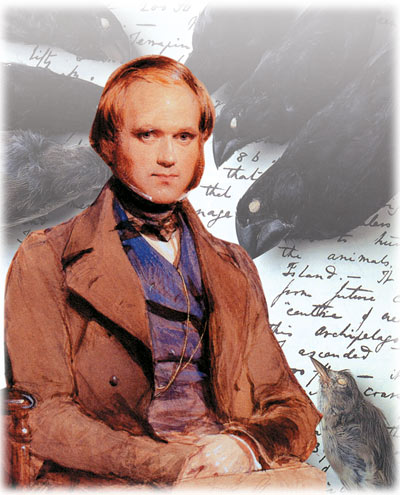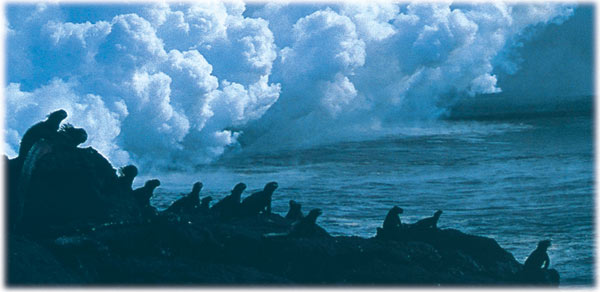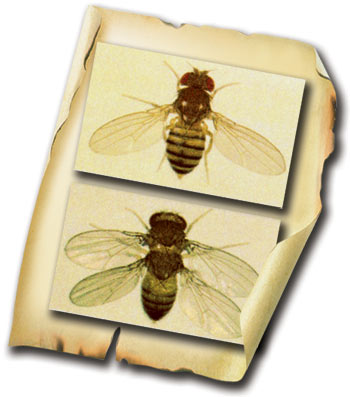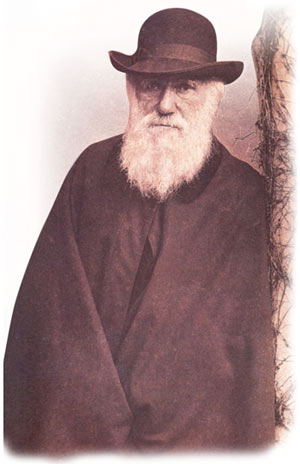Once, the Origin of Species was Thought to Lie in "Speciation"
On June 14, 2003, an article entitled "How Are New Species Formed?" appeared in New Scientist, noted for its avid support of Darwinism. The author, George Turner, made this important admission:
Not long ago, we thought we knew how species formed. We believed that the process almost always started with complete isolation of populations. It often occurred after a population had gone through a severe "genetic bottleneck", as might happen after a pregnant female was swept off to a remote island and her offspring mated with each other. The beauty of this so-called "founder effect" model was that it could be tested in the lab. In reality, it just didn't hold up. Despite evolutionary biologists' best efforts, nobody has even got close to creating a new species from a founder population. What's more, as far as we know, no new species has formed as a result of humans releasing small numbers of organisms into alien environments.102
 |
| Charles Darwin |
Actually, this admission is not new. In the century and a half since Darwin, no speciation such as he proposed has ever been observed, and no satisfactory explanation has ever been provided for the origin of species.
To explain this, it will be useful to examine what sort of "speciation" Darwin envisioned.
His theory depended on the observation of variations in the animal populations. Some of these observations were made by individuals who bred animals, raising quality breeds of dogs, cows or pigeons. From among the population, they selected ones with a desirable characteristic (for example, dogs that could run fast, cows that produced good milk or "smart" pigeons), and bred them. Within a few generations, their resulting offspring had a high proportion of the selected qualities. For example, the cows produced much more milk than ordinary cows.
This kind of "limited variation" made Darwin think that modification is continual in nature, and when it is extended over a long enough period of time, it produces a radical change, that is, evolution.
Darwin's second observation along these lines was that the various breeds of finches he saw in the Galapagos Islands had differently-shaped bills than finches on the mainland. In the islands, long-billed, short-billed, curved-billed and straight-billed strains of finches developed in the same population. Darwin concluded that these varieties turned into separate species by mating among themselves.
When Darwin assembled all these instances of variation, he was led to think that unlimited modification occurred in nature and that to develop brand-new species, orders and classes, only a long period of time was required. But Darwin was wrong.
When individuals with a given dominant characteristic are selected and bred, only better and stronger members of that species are produced. But this selective breeding can't possibly produce a different species. For example, a horse cannot descend from a cat, nor a giraffe from a gazelle, or a plum from a pear. Peaches do not turn into bananas nor do carnations turn into roses. In short, under no conditions can one species arise from another. The following pages will detail how Darwin was wrong on this matter.
The Natural Limits of Biological Change
 | |
| Loren Eisley | |
Darwin supposed that the variations he observed in nature were never-ending. He thought that if only a few generations could show a change in cows, dogs and pigeons, then their entire structure could undergo alteration if given enough time. But in the 150 years that have passed since then, countless different experiments and observations have proven this supposition to be utterly false.
All 20th-century attempts to breed animals and produce hybrid plants have revealed limits that can never be crossed in the processes of natural variation. One of the most famous names in this field is Luther Burbank, who believed that there is a hidden law in species that limits their variation:
I know from my experience that I can develop a plum half an inch long or one two and a half inches long, with every possible length in between, but I am willing to admit that it is hopeless to try to get a plum the size of a small pea, or one as big as a grapefruit...In short, there are limits to the development possible, and these limits follow a law...Experiments carried on extensively have given us scientific proof of what we had already guessed by observation; namely that plants and animals all tend to revert, in successive generations, toward a given mean or average...In short, there is undoubtedly a pull toward the mean which keeps all living things within some more or less fixed limitations.103
Today, artificial means can make a few genetic changes in the biological structure of animals and agricultural products. Stronger horses and bigger cabbages can be produced. But Darwin clearly drew the wrong deductions from these instances. Loren Eisley, one of the world's most prominent anthropologists, explains:
It would appear that careful domestic breeding, whatever it may do to improve the quality of race horses or cabbages, is not actually in itself the road to the endless biological deviation which is evolution. There is great irony in this situation, for more than almost any other single factor, domestic breeding has been used as an argument for ...evolution.104
And Edward S. Deevey, a biologist and ecologist at the University of Florida, points out that there is a limitation to variation in nature: "Wheat is still wheat, and not, for instance, grapefruit; and we can no more grow wings on pigs than hens can make cylindrical eggs." 105
 |
| Ernst Mayr |
Experiments conducted on fruit flies also struck the wall of "genetic limitation." In all of these experiments, fruit flies underwent changes to a certain extent, but beyond that limit, no change was observed. Ernst Mayr, a well-known neo-Darwinist, reports from two experiments done on fruit flies:
In the starting stock, the combined average bristle number of males and females on these segments was about 36. Selection for low bristle number was able to lower this average after 30 generations to 25 chaetae, after which the line soon died out owing to sterility...In the "high line" (selection for high bristle number), progress was at first rapid and steady. Within 20 generations bristle number had risen from 36 to an average 56, without marked spurts or plateaus. At this stage sterility became severe.106
After these experiments, Mayr reached the following conclusion:
Obviously any drastic improvement under selection must seriously deplete the store of genetic variability...The most frequent correlated response of one-sided selection is a drop in general fitness. This plagues virtually every breeding experiment.107
One of the most important texts dealing with this subject is Natural Limits to Biological Change written by biology professor Lane P. Lester and molecular biologist Raymond G. Bohlin. In their book's introduction, they write:
That populations of living organisms may change in their anatomy, physiology, genetic structure, etc., over a period of time is beyond question. What remains elusive is the answer to the question, How much change is possible, and by what genetic mechanism will these changes take place? Plant and animal breeders can marshal an impressive array of examples to demonstrate the extent to which living systems can be altered. But when a breeder begins with a dog, he ends up with a dog—a rather strange looking one perhaps, but a dog nonetheless. A fruit fly remains a fruit fly; a rose, a rose, and so on.108
The authors studied this subject with scientific observations and experiments and arrived at two basic conclusions:
- 1) No new genetic data can be obtained without external interference in the genes of organisms. Without such interference, new biological data cannot appear in nature. That is, new species, new organs, and new structures cannot come into being. It is only "genetic variation" that occurs naturally in a given species. These limited alterations include the development of, for example, shorter, larger, short-haired or long-haired breeds of dogs. Even given a million years, these variations will never produce new species or higher taxa (genera, families, orders, classes, phyla).
- 2) In nature, external interference with the genes of organisms comes about only through mutations. But these mutations are never beneficial nor produce new genetic data; they only destroy the existing one.
Therefore, it is impossible to explain the "origin of species" in terms of natural selection, as Darwin thought to do. No matter how much "selection" dogs are subjected to, they will always remain dogs; there is no sense in asserting that they were actually fish or bacteria in the past.
So, what of the "external interference" in the genes, or mutations?
Since the 1930s the Darwinist theory has relied on this alternative, and for this reason, the theory's name was changed to "neo-Darwinism." However, mutations were not able to rescue the theory—an important topic to examine separately.
Galapagos Creatures Refute Evolution
The various finches that Darwin observed in the Galapagos were an example of variation and, as with other examples, offered no definite proof for evolution. Observations made in the last few years have shown that finches have not undergone the kind of limitless alteration that Darwin's theory supposed. Moreover, most of the different types of finches, which Darwin thought to represent 14 separate species, were actually variations of the same species, able to mate with one another. Scientific observations have shown that the example of the finch's bill, cited by almost all evolutionist literature, is actually an example of variation which affords no proof for the theory of evolution. Peter and Rosemary Grant went to the Galapagos to look for proof for the so-called Darwinian evolution and spent years observing the finches on the islands; in their well-known study, they managed only to document the fact that evolution had not occurred.109
 |
What Good are Mutations?
 |
| The extra wings of four-winged mutant fruit flies possess no flight muscles, and are examples of a handicap rather than of development. |
The data contained in the gene is highly complex, as are the molecular "machines" that code it, read it and perform their productive functions accordingly. No random event that can affect this system, and no "accident" can bring about any increase in the amount of genetic data.
Imagine a computer programmer engaged in writing a software when on computer and a book falls on his keyboard, striking a few keys and inserting random letters and numbers into the text. A mutation is something like this. Just as such an accident would contribute nothing to the computer program—in fact, it would ruin it—so mutations vandalize the genetic code. In Natural Limits to Biological Change, Lester and Bohlin write that "mutations are mistakes, errors in the precise machinery of DNA replication" which means "mutations, genetic variation, and recombination by themselves will not generate major evolutionary change." 110
This logically expected result was proven by observations and experiments in the 20th century. No mutation was observed to improve the genetic data of an organism so as to cause a radical change.
For this reason, despite the fact that he accepts the theory of evolution, Pierre-Paul Grassé, former president of the French Academy of Sciences, says that mutations are "merely hereditary fluctuations around a median position; a swing to the right, a swing to the left, but no final evolutionary effect...They modify what preexists." 111
Dr. Grassé says that in the case of evolution, the problem is that "some contemporary biologists, as soon as they observe a mutation, talk about evolution." In his view, this opinion does not agree with the facts because "no matter how numerous they may be, mutations do not produce any kind of evolution." 112
 |
| Genes, in which are coded all forms of information about the structures and features of living things, are damaged as a result of mutations—destructive effects that you can clearly see in the picture to the side. It is therefore impossible for mutations to make any contribution to the origin of a new species. |
The best evidence that mutations do not produce new genetic data is that of the fruit fly. Mutations done to fruit flies show that in nature, balance, not change, dominates organisms. Due to the fast gestation period of fruit flies, which lasts only 12 days, for years they have been the favorite subject of mutation experiments. In order to increase the mutation rate by 15,000 percent, X-rays were used in these experiments. Scientists could observe fruit flies that, in a short time, were subjected to the number of mutations they would be exposed to for millions of years under natural conditions. But even such rapid mutations produced no new species. Scientists were not able to obtain any new genetic data.
In fruit flies, the classic case of supposed "beneficial mutation" is the instance of the four-winged mutant. Normally, fruit flies have two wings, but some with four wings have hatched occasionally. Darwinist literature offers this example as a "development," but as Jonathan Wells has shown in detail in his Icons of Evolution, this interpretation is wrong. These extra wings have no muscles for flying and so are actually disadvantages to the fruit fly. And not one of these mutants has survived outside a laboratory.113
Despite all this, evolutionists assert that beneficial instances of mutation do occur, even if rarely; and that through natural selection, new biological structures come into being. However, this is a major error. A mutation certainly brings about no increase in genetic data and, therefore, does not foster evolution. As Lester and Bohlin explain:
Mutations will be capable only of modifying what already exists, usually in a meaningless or deleterious way. That is not to say that beneficial mutation is prohibited; unexpected maybe, but not impossible. A beneficial mutation is simply one that makes it possible for its possessors to contribute more offspring to future generations than do those creatures that lack the mutation...But these mutations have nothing to do with changing one kind of organism into another. . .
In this regard, Darwin called attention to the wingless beetles of Madeira. For a beetle living on a windy island, wings can be a definite disadvantage. Mutations causing the loss of flight are definitely beneficial. Similar would be the case of sightless cavefish. Eyes are quite vulnerable to injury, and a creature that lives in total darkness would benefit from mutations reducing their vulnerability. While these mutations produce a drastic and beneficial change, it is important to notice that they always involve loss, never gain. One never observes wings or eyes being produced in species that did not previously possess them.114
Therefore, Lester and Bohlin conclude that overall, mutations are always a cause of genetic impairment and degeneration.
Mutations always cause a loss of genetic data; to believe that they produced the extraordinarily complex genetic codes of the millions of different species is like believing that books falling randomly onto a computer keyboard have written millions of encyclopedias. It is unthinkable nonsense. Dr. Merle d'Aubigne, head of the Orthopedic Department at the University of Paris, makes this important comment:
I cannot be satisfied by the idea that fortuitous mutation ...can explain the complex and rational organization of the brain, but also of lungs, heart, kidneys, and even joints and muscles. How is it possible to escape the idea of some intelligent and organizing force?115
In short, mutations do not explain Darwin's "origin of species." The Austrian evolutionist biologist Gerhard Müller, in a book review he wrote for the winter 2006 issue of the Biological Theory journal, admits the inability of the neo-Darwinian synthetic theory to account for the origin of morphological novelty.
Neo-Darwinism cannot explain the origin of living creatures in terms of its two mechanisms, natural selection and mutation. No genetic data can be yielded through natural selection; only the existing data is selected. Nor do mutations produce new genetic data; they rarely do not affect the existing data but usually destroy it. Clearly the origins of genetic data—and therefore, life—have none of these mindless natural mechanisms.
As Dr. Merle d'Aubigne stated, this origin is an "intelligent and organizing force." This power is Almighty God with His endless intelligence, knowledge and might. In the Qur'an, God says:
It is He Who originated creation and then regenerates it. That is very easy for Him. His is the most exalted designation in the heavens and the Earth. He is the Almighty, the All-Wise. (Surat ar-Rum: 27)
Darwinism has tried to deny this reality, but has not succeeded; it has become an outmoded theory buried in history.
The End of "Just-So Stories"
 |
| Darwin was unable to account for "the origin of species," and it cannot be resolved by Darwinism. |
The attempt to explain the origin of species in terms of evolution has come to an impasse, as has been openly admitted by evolutionists over the past few years. The situation is summed up in a 1996 article by evolutionist biologists Gilbert, Opitz and Raff in the magazine, Developmental Biology. They write: "the origin of species—Darwin's problem—remains unsolved."116
But the man in the street is not aware of this situation. The Darwinist system prefers not to let the public know that in Darwin's terms, the question of the origin of species is unanswerable. Instead, through media and textbooks, it repeats the myths of evolution. In the world of science, these myths are called "just-so stories" and constitute the main source of motivation for those who accept the theory.
You will find one of the most familiar of these stories—about how humans came to walk on two feet—in almost every evolutionist text, with slight variations: Humanoid primates that were the ancestors of human beings lived among the trees in the African jungles. Their spines were stooped, and their hands and feet ideally shaped for clinging onto branches. Africa's jungle expanses later shrank, and humanoids migrated to the savannah. In order to be able to see above the savannah's tall grasses, they needed to stand upright, in other words on their feet. Thus it was that our ancestors came to stand and walk erect. Their hands were now off the ground; and as a result they began using their hands to make tools. The more they used their hands, the more their intelligence grew. They thus turned into human beings.
You can often find stories like this in evolutionist newspapers and magazines. Reporters who accept the theory of evolution, or whose knowledge of it is limited or superficial, relate these stories to their readers as if they were factual. However, more and more scientists proclaim that they have no scientific value. Dr. Collin Patterson, for years the senior paleontologist at the British Museum of Natural History in London, writes:
It is easy enough to make up stories of how one form gave rise to another, and to find reasons why the stages should be favored by natural selection. But such stories are not part of science, for there is no way of putting them to the test. 117
And in his book Fossils and Evolution (1999), the evolutionist paleontologist T.S. Kemp takes up the lack of scientific value in what has been written about the supposed evolution of birds:
A scenario for the origin of birds might be that during the Late Jurassic there was a selection pressure favouring the adoption of increasingly arboreal [tree-dwelling] habits acting on a group of small, lightly built bipedal dinosaurs. Arboreality increased their ability to escape predators and find new food sources. Subsequent selection forces promoted leaping, then gliding, and eventually powered flight from branch to branch and tree to tree. Absolutely none of these suppositions about the intermediate forms, the ecological conditions they lived in, or the selective forces to which they were subjected could be tested empirically. The outcome is the evolutionary scenario or, rather more pejoratively, the "Just-so Story".118
 |
| Lamarck's erroneous thesis was scientifically dismantled, though attempts are still being made to fix it in people's minds. |
The subject that Patterson and Kemp deal with—that "just-so stories" cannot be tested and therefore have no scientific value—is only one aspect of the problem. A second, perhaps more important, aspect is that apart from the fact that these stories have no scientific support, they are impossible nonsense.
To explain why, let us return to the story of the "hominoids that started to walk on two feet."
Jean Baptiste Lamarck invented this myth in the unsophisticated scientific world of 150 years ago. However, modern genetics has shown that a characteristic acquired over a lifetime is not passed down to the next generation. The relevance of this lies in the supposition that the so-called ancestors of human beings evolved with characteristics they had acquired during their lifetime. This scenario claims that hominoids stood up on their hind feet to see above the vegetation, freeing their hands for use, and as a result, their intelligence developed. Nothing of this sort ever happened. Besides, it is not possible for a creature to acquire characteristics simply by trying to stand up straight and by using hand tools. Even if we accept the possibility of such acquisition (which is scientifically impossible), these skills cannot be passed on to the next generation. Therefore, even if the impossible did take place and one ape could force its skeleton into an upright position, it could not pass on this habit to its offspring, and evolution would not occur.
So, why is this Lamarckian idea, discredited for more than a century, still trying to impose itself on society?
Evolutionists say that these "just-so stories" encapsulate an actual process of biological evolution. They do not believe that necessity gives birth to evolution, but that necessity guides natural selection in a particular direction. They also believe that it causes the selection of the mutations that will bring about results in that direction. That is, when they maintain that hominoids stood up on two feet, they are actually saying that it would have been advantageous for them to stand on two feet. Some stood up straight, with a skeleton that had mutated at just the right time; and those that stood up straight were chosen by natural selection.
In other words, the scientific explanations relevant to the mutation are completely ignored, because if these details are examined, it will appear that they are merely unscientific superstitions.
The evolutionists' just-so stories suppose that mutations will appear to supply whatever an organism needs and to ensure whatever advantages would suit it best.
Moreover, no mutation has been observed so far that develops genetic data.
To believe in this scenario is like believing in a magic wand that supplies a creature's every need. It is superstition.
Even though the French zoologist Pierre-Paul Grassé theoretically accepts evolution, he is aware of the reality of the situation and has come out strongly against Darwinism in describing its strange belief about mutations:
The opportune appearance of mutations permitting animals and plants to meet their needs seems hard to believe. Yet the Darwinian theory is even more demanding. A single plant, a single animal would require thousands and thousands of ...appropriate events. Thus, miracles would become the rule: events with an infinitesimal probability could not fail to occur...There is no law against daydreaming, but science must not indulge in it.119
In short, Darwinism is a figment of the imagination with nothing to do with science. And the just-so stories presented as scientific fact have not the slightest scientific support.
All these myths have in common the supposition that living things' special needs are first determined and then supplied by mutations. Evolutionists call this need "evolutionary pressure." (For example, the need to stand up on two feet in the high grass of the savannah is a so-called "evolutionary pressure.")
 |
| Hands crippled due to mutations |
Only those who blindly accept Darwinism can possibly suppose that the necessary mutations are ready at hand. Everyone not caught up in such blind dogmatism can see that just-so stories are inventions with no relation to science.
Indeed, the nature of such conjectures is now openly admitted by evolutionist scientists. A new example is the comment by Ian Tattersall, curator in the Division of Anthropology at the American Museum of Natural History, on an article in The New York Times, titled "Why Humans and Their Fur Parted Ways." The answer proposed was the scenario of having various advantages. Tattersall said, "There are all kinds of notions as to the advantage of hair loss, but they are all just-so stories." 120
In his 1999 book, evolutionist Henry Gee, science editor of Nature magazine, wrote that it is wrong to attempt to explain an organ's origin in terms of what is advantageous for it:
...our noses were made to carry spectacles, so we have spectacles. Yet evolutionary biologists do much the same thing when they interpret any structure in terms of adaptation to current utility while failing to acknowledge that current utility needs tell us nothing about how structure evolved, or indeed how the evolutionary history of a structure might itself have influenced the shape and properties of that structure. 121
These statements are very important because in future, you will probably encounter such "just-so stories" in evolutionist literature and especially in the media. Remember, these vain stories rest on no scientific proof. The same method is always used in their production. First, the advantage of a creature's particular characteristic or aspect is described, then a scenario is invented to show how this advantage could have evolved. In practice, of course, there's no limit to the evolutionist theses that could be produced in this way: "The trunk gives the elephant the ability to gather food from the ground, so it must have evolved for that purpose," or "The giraffe's neck enables it to reach higher branches so it must have evolved to let the animal do so." To accept this is to believe that nature looks after the needs of its every creature. That is, it is the same as believing a myth.
The nature of this myth is becoming clearer and clearer every day.
Reviewing what we've examined since the beginning of this chapter, claiming that the origin of species is a random evolutionary process was the result of wrong deductions Darwin made in the scientifically unsophisticated 19th century. Every 20th-century observation and experiment shows that no mechanism in nature produces new species, much less higher taxa of living things.
Now that science has destroyed the Darwinist error, it has come to light that the true origin of species lies in Creation. Almighty God, with His supreme knowledge, has created every living creature.
Footnotes
103- George Turner, "How Are New Species Formed?", New Scientist, June 14, 2003, s.36
104- Norman Macbeth, Darwin Retried, Boston, Gambit INC., 1971, s.36.
105- Norman Macbeth, Darwin Retried, ss.35-36
106- Edward S. Deevy, "The Reply: Letter from Birnam Wood", Yale Review, 56 (1967), s.636
Ernst Mayr, Animal Species and Evolution, Cambridge, Harvard University Pres, 1963, ss.285-286.
108- Ernst Mayr, Animal Species and Evolution, ss.290.
109- Lane P. Lester, Raymond G. Bohlin, Natural Limits to Biological Change, s.13-14
110- Jonathan Wells, Icons of Evolution, ss.159-175
111- Lane Lester, Raymond G. Bohlin, Natural Limits to Biological Change, 2nd ed, Probe Books, 1989, ss.67,70
112- Garry E. Parker, Creation: The Facts of Life, San Diego, Creation of Life Publishers, 1980, s.76
113- Pierre-Paul Grassé, Evolution of Living Organisms, Academic Press, New York, 1977, s. 88
114- Jonathan Wells, Icons of Evolution (Regnery, 2000), s. 178
115- Lane Lester, Raymon G. Bohlin, Natural Limits to Biological Change, Probe Books, 1989, s. 170-171
116- Henry Morgenau & Roy Abraham Varghese, Kosmos Bios Teos, Gelenek Yayıncılık, Ekim 2002, İstanbul, s.161.
117- Scott Gilbert, John Opitz, and Rudolf Raff, "Resynthesizing Evolutionary and Developmental Biology", Developmental Biology 173, Article No. 0032, 1996, s. 361
118- Personal letter (written 10 April 1979) from Dr. Collin Patterson, Senior Paleontologist at the British Museum of Natural History in London, to Luther D. Sunderland; as quoted in Darwin's Enigma by Luther D. Sunderland, Master Books, San Diego, USA, 1984, s. 89
119- T. S. Kemp, Fossils and Evolution, Oxford University Press, 1999, s. 19
120- Pierre-P Grassé, Evolution of Living Organisms, New York: Academic Press, 1977, s.103
121- Nicholas Wade, "Why Humans and Their Fur Parted Ways", The New York Times, 19 Ağustos 2003
122- Henry Gee, In Search Of Deep Time: Beyond The Fossil Record To A New Hıstory Of Life, The Free Press, A Division of Simon & Schuster, Inc., 1999, s. 103
- Introduction
- Darwinism's Crumbling Myths and the Correct Definition of Science
- Once, Life was Thought to be Simple
- Once, the Fossil Record was Thought to Prove Evolution
- Once, There was a Search for the Missing Link
- Once, There was no Knowledge of Biological Information
- Once, It was Believed that There was "Embryological Evidence for Evolution"
- Once, There was the Myth of Faulty Characteristics
- Once, There was the Myth of "Junk" DNA
- Once, the Origin of Species was Thought to Lie in
- Once, There was the "Horse Series" Scenario
- Once, There was the Story of Peppered Moths
- Until Recently, There were Stories of the Dino-Bird
- Conclusion
